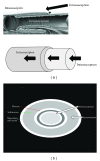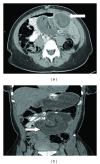Intussusception after laparoscopic gastric bypass surgery: an underrecognized complication
- PMID: 22991661
- PMCID: PMC3444049
- DOI: 10.1155/2012/464853
Intussusception after laparoscopic gastric bypass surgery: an underrecognized complication
Abstract
Introduction. Intussusception after bariatric surgery is an uncommon complication that is now being frequently reported. Most people consider dysmotility to be the causative mechanism in the absence of obvious etiology. Material and Methods. A worldwide search identified literature describing intussusception after bariatric surgery. We also included our own patients and analyzed information regarding demographic profile, risk factors, presentation, diagnosis, and post treatment course. Results. Seventy one patients were identified between 1991 and 2011. Majority of the affected patients were females (n = 70, 98.6%); median time to presentation after gastric bypass surgery was 36 months. Most patients presented with abdominal pain, nausea and vomiting, but without obvious peritonitis. Sixty eight patients (96%) required surgery; 48 (70.6%) underwent revision of anastomosis, 16 (23.5%) had reduction without resection, while 4 patients (5.9%) had plication only. Amongst these, most patients (n = 51, 75%) were found to have retrograde intussusception. Post-operatively, 9 patients presented with recurrence (range, 0.5-32 months). Five patients, who had earlier been treated without resection, eventually required revision of the anastomosis. There was no mortality noted. Conclusion. Intussusception after bariatric surgery is uncommon and its diagnosis is based on a combination of physicial, radiological and operative findings. An early surgical intervention reduces morbidity and prevents recurrence.
Figures




Similar articles
-
Intussusception after laparoscopic one anastomosis gastric bypass: A rare complication.Int J Surg Case Rep. 2019;60:270-272. doi: 10.1016/j.ijscr.2019.06.014. Epub 2019 Jun 13. Int J Surg Case Rep. 2019. PMID: 31261045 Free PMC article.
-
Retrograde (reverse) jejunal intussusception might not be such a rare problem: a single group's experience of 23 cases.Surg Obes Relat Dis. 2008 Mar-Apr;4(2):77-83. doi: 10.1016/j.soard.2007.12.004. Epub 2008 Mar 4. Surg Obes Relat Dis. 2008. PMID: 18294922
-
Intussusception after Roux-en-Y gastric bypass.Surg Obes Relat Dis. 2014 Jul-Aug;10(4):666-70. doi: 10.1016/j.soard.2014.01.026. Epub 2014 Jan 30. Surg Obes Relat Dis. 2014. PMID: 24935180
-
Small bowel intussusception in pregnant women with a history of a Roux-en-Y gastric bypass: a case series and a systematic review of the literature.Surg Obes Relat Dis. 2020 Oct;16(10):1603-1613. doi: 10.1016/j.soard.2020.05.019. Epub 2020 Jun 1. Surg Obes Relat Dis. 2020. PMID: 32737008
-
Management of surgical complications of previous bariatric surgery in pregnant women. A systematic review from the BARIA-MAT Study Group.Surg Obes Relat Dis. 2020 Feb;16(2):312-331. doi: 10.1016/j.soard.2019.10.022. Epub 2019 Oct 31. Surg Obes Relat Dis. 2020. PMID: 31837948
Cited by
-
Intussusception After Bariatric Surgery.J Gastrointest Surg. 2019 Mar;23(3):597-598. doi: 10.1007/s11605-018-3814-x. Epub 2018 May 29. J Gastrointest Surg. 2019. PMID: 29845569
-
Intussusception following diaphragmatic rupture surgery: A rare case.Int J Surg Case Rep. 2023 Nov;112:108953. doi: 10.1016/j.ijscr.2023.108953. Epub 2023 Oct 17. Int J Surg Case Rep. 2023. PMID: 37856974 Free PMC article.
-
Intussusception Within a Jejunostomy With Closed Loop Obstruction: A Case Report.Cureus. 2024 Aug 11;16(8):e66644. doi: 10.7759/cureus.66644. eCollection 2024 Aug. Cureus. 2024. PMID: 39258089 Free PMC article.
-
Intussusception after open Roux-en-Y gastric bypass managed with laparoscopic reduction.J Surg Case Rep. 2021 Aug 10;2021(8):rjab339. doi: 10.1093/jscr/rjab339. eCollection 2021 Aug. J Surg Case Rep. 2021. PMID: 34386192 Free PMC article.
-
Unique long-term simultaneous complications of conventional Roux-en-Y gastric bypass after 27 years: A case report.Int J Surg Case Rep. 2022 Dec;101:107787. doi: 10.1016/j.ijscr.2022.107787. Epub 2022 Nov 23. Int J Surg Case Rep. 2022. PMID: 36434869 Free PMC article.
References
-
- CDC Statistics on Obesity, http://www.cdc.gov/obesity/data/trends.html.
-
- Wolfe BM, Morton JM. Weighing in on bariatric surgery: procedure use, readmission rates, and mortality. Journal of the American Medical Association. 2005;294(15):1960–1963. - PubMed
-
- Arcila D, Velázquez D, Gamino R, et al. Quality of life in bariatric surgery. Obesity Surgery. 2002;12(5):661–665. - PubMed
-
- Samuel I, Mason EE, Renquist KE, Huang YH, Zimmerman MB, Jamal M. Bariatric surgery trends: an 18-year report from the International Bariatric Surgery Registry. American Journal of Surgery. 2006;192(5):657–662. - PubMed
-
- Adams TD, Gress RE, Smith SC, et al. Long-term mortality after gastric bypass surgery. New England Journal of Medicine. 2007;357(8):753–761. - PubMed
LinkOut - more resources
Full Text Sources

